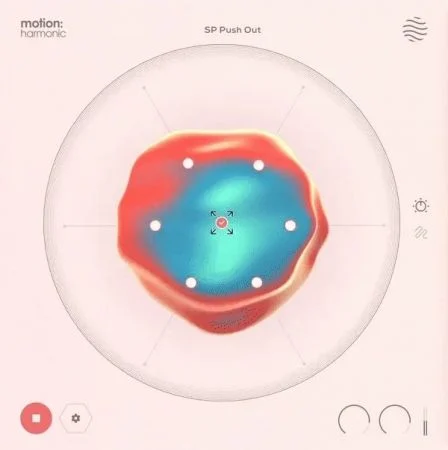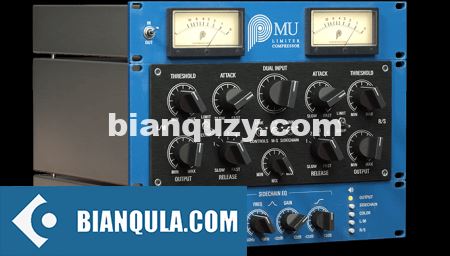Excite Audio Motion Harmonic 1.2.0 WIN MAC

TeamCubeadooby | 27 May 2023 | 7 MB
点燃你的创意流
失真和滤波器与交互式声音塑造体验相结合,旨在为您的音频增添动感。
Motion: Harmonic 在失真、滤波和比特粉碎方面开辟了新领域,让您处于动态和响应式声音塑造体验的中心。 现在,通过创新的反应式 Hexagon 控制器,您的音频信号转换将成为一种动画、视觉引导和创意的体验。
从微妙的加热和塑形到强烈的调制信号破坏,Motion: Harmonic 让您所需的一切触手可及。 失真、比特粉碎和滤波的综合参数将这些效果带入新的创意领域,多峰滤波器和动态失真等工具为您提供了玩声音的新方法。
Hexagon 与主视图中的脉动和反应性 3D 对象一起提供了六个宏滑块,可以分配这些滑块来控制插件的任何效果参数。 然后,这些滑块对“磁性”光标做出反应,可以使用鼠标移动记录其路径或以图形方式绘制其路径。
•Bitcrush + 失真效果
•磁性光标控制
•反应式3D可视化工具
•互动六边形区
•6 个宏滑块
六边形:反应式动画
六边形控制区域以新尺寸改进了传统 XY 键盘的概念,是 Motion: Harmonic 中最重要的部分,允许以反应性和创造性的方式将其六个宏滑块推拉在一起。
六个滑块充当插件中任何失真、滤波或调制参数的宏控制。 然后滑块本身会被鼠标光标周围的磁场移动。
您的光标移动可以实时播放、录制或预编程; 然后通过广泛的同步和播放选项进行控制。
此外,将任何效果参数分配给六边形的中心意味着它们的属性将由传入的音频电平进行调制。
采取行动
您在六边形内的运动可以吸引或排斥宏滑块,并且可以自定义磁场的范围和强度,并且可以使用保持和释放计时参数来更改宏滑块的行为。 您的动作路径可以通过多种方式创建和回放……
可以使用鼠标光标自由记录路径,也可以使用绘图和编辑功能设计路径。 使用鼠标记录路径,您可以试听和修剪录音以磨练您的理想模式。 自己设计路径是完全可定制的——您可以创建、编辑或删除点以及它们之间的曲线。
一旦路径形状完全形成,时间轴就可以为回放和触发方式提供充分的灵活性。 播放可以循环播放或由 DAW 触发,播放方向可以设置为向前、向后或摆动。
您可以将播放同步到 DAW 的速度或以毫秒为单位运行路径,甚至可以改变光标在路径中移动的速度,在播放期间加速或减速。
例如,您可以选择用鼠标记录缓慢、小心的移动,然后加速并触发它作为一个动作。 或者,您可以使用点和曲线仔细设计一个复杂的动作,并将其设置为非常缓慢地播放,将静态循环转变为整个乐曲过程中不断演变的模式。
Bitcrusher:美味降解
设置位深度和采样率以降低信号保真度,模拟早期数字系统的质感和感觉。 当您想要保留声音的主体时,调高“动态”控件可将比特粉碎效果集中到瞬变上。 或者使用 Lo 和 Hi 滑块将效果集中到特定频段,以保持音频频谱的其余部分不受影响。
Bitcrusher 可以使用预滤波器进行处理,在 Bitcrusher 之前滚降低点或高点,以提高信号清晰度。 它还提供了一个混合控制来抑制破坏性效果,将原始信号混合回来。
失真:带有反馈的热量
使用驱动器和音调控件调节您喜欢的失真风格,并使用字符旋钮在磁带、电子管和法兹算法之间平滑过渡。 使用“动态”参数或多或少地对输入信号中的瞬变的失真响应进行加权,或者将失真效果集中在您选择的特定频段上。
运动:谐波的失真部分还包含一个反馈控制,通过振铃反馈环路添加失真效果 – 向上或向下转动频率以定制该谐振效果的频率。 您还可以找到混音控制以及低输入和高输入过滤。
切换失真和比特粉碎可视化工具,以显示您的设置对湿信号的实时影响,并将输出与干信号进行比较。
Ignite Your Creative Flow
Distortion and filters combine with an interactive sound-shaping experience designed to add movement to your audio.
Motion: Harmonic opens up new frontiers in distortion, filtering and bitcrushing, placing you at the centre of a dynamic and responsive sound-shaping experience. Transforming your audio signal is now an animated, visually-led and creative experience with the innovative and reactive Hexagon controller.
From subtle warming and shaping to intense modulated signal destruction, Motion: Harmonic puts everything you need at your fingertips. Comprehensive parameters for distortion, bitcrushing and filtering take these effects into new creative territory, with tools like the multipeak filter and dynamic distortion giving you new ways to play with sound.
The Hexagon, alongside a pulsating and reactive 3D object in the main view, offers six macro sliders that can be assigned to control any of the plugin’s effect parameters. These sliders then react to a ‘magnetic’ cursor whose path can be recorded using mouse movements or drawn graphically.
•Bitcrush + Distortion Effects
•Magnetic Cursor Control
•Reactive 3D Visualiser
•Interactive Hexagon Area
•6 Macro Sliders
The Hexagon: Reactive Animation
Improving upon the concept of the traditional XY pad with new dimensions, the hexagonal control area is first-and-foremost in Motion: Harmonic, allowing its six macro sliders to be pushed and pulled together, in a reactive and creative way.
The six sliders act as macro controls for any distortion, filtering or modulation parameter in the plugin. The sliders themselves are then moved by a magnetic field surrounding the mouse cursor.
Your cursor movements can be played live, recorded or pre-programmed; then controlled with extensive syncing and playback options.
In addition, assigning any effect parameters to the centre of the hexagon means their properties will be modulated by the incoming audio level.
Making the Moves
Your motions within the Hexagon can attract or repel macro sliders, and your magnetic field can be customised for its Range and Strength and the macros’ slider’s behaviour can be changed using Hold and Release timing parameters. The path of your motions can be created and played back in many ways…
Paths can be recorded freely using the mouse cursor or designed using drawing and editing functions. Record a path using the mouse, and you can audition and trim the recording to hone in on your ideal pattern. Designing a path yourself is fully customisable – you can create, edit or remove points, and curve lines between them.
Once your path shape is fully formed, the Timeline provides full flexibility for how it’s played back and triggered. Playback can be looped or triggered by your DAW, and playback direction can be set between Forward, Backward or Pendulum.
You can sync playback to your DAW’s tempo or run the path in milliseconds, and even the speed of the cursor’s movement through the path can be made variable, accelerating or decelerating during playback.
You might, for example, choose to record a slow, careful movement with your mouse then speed it up and trigger it as a flourish. Or you may carefully design a complex movement using points and curves, and set it to play very slowly, transforming a static loop into a continually evolving pattern throughout the course of a whole piece.
Bitcrusher: Flavoursome Degradation
Set the bit depth and sample rate to bring your signal’s fidelity down, emulating the grit and feeling of early digital systems. Turn up the Dynamic control to focus the bitcrushing effect onto transients, for when you want to retain the body of your sound. Or use the Lo and Hi sliders to focus the effect onto a particular band of frequencies to keep the rest of the audio spectrum unaffected.
The bitcrusher can be treated with pre-filters, rolling off lows or highs before bitcrushing for increased signal clarity. It also provides a Mix control to tame the destructive effects, blending the original signal back in.
Distortion: Heat with Feedback
Dial in your preferred flavour of distortion using the Drive and Tone controls, and smoothly transition between tape, tube and fuzz algorithms using the Character dial. Use the Dynamic parameter to weight the distortion’s response more or less heavily to transients in the input signal, or focus the distortion effect on a particular frequency band of your choice.
Motion: Harmonic’s distortion section also houses a Feedback control, adding to the distortion effect with a ringing feedback loop – turn the Frequency up or down to tailor the frequency of this resonant effect. You’ll also find a Mix control and low- and high- input filtering.
Toggle the distortion and bitcrushing visualisers to reveal the real-time effects your settings have on the wet signal and compare the output to your dry signal.
Filtering: Highlight and Sculpt
When modulated by Motion: Harmonic’s Hexagon controller, these high-pass and low-pass filters, with frequency, slope and resonance controls, can provide anything from distortion-calming and slow, undulating effects to rhythmic sweeps and chops.
The filter effects can be placed before or after the Bitcrushing and Distortion modules withe the Post FX buttons.
The Peak Filter allows you to dial in a symmetrical bank of peaks or notches to replicate complex audio effects like spectral resonance or a shifting phaser sound.
Use the No. control to increase the number of peaks, and the Frequency and Q controls to change their position and shape.
The Contrast and Invert switches add further flexibility and customisation to this unique module’s usage.
Toggle the peak filter and LP/HP visualisers to reveal the spectrum analysers and the curves of the filters across the frequency range .
Whats new in this version
Official site does not provide any info about changes in this version.
System Requirements
Windows 7 or newer
Homepage
httpss://anonymz.com/…/motionharmonic





